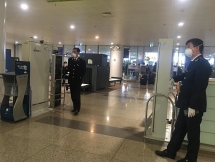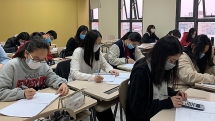Remote students are having difficult time during Covid pandemic, study shows
 |
| Remote students were slightly more likely to fret about grades than their peers in the classroom, and they also reported doing more homework per week, a new study found. Jackson Joyce / for NBC News |
There’s no question that the pandemic has been hard on children, whether or not their schools have reopened. A flood of research in recent months has found alarming spikes in depression and anxiety among children and their parents. Multiple studies have found that students — especially those with disabilities and from low-income families — are learning less than they should.
But a new study from NBC News and Challenge Success, a nonprofit affiliated with the Stanford Graduate School of Education, is one of the first to shed light on the differences between students whose classes have been exclusively online and those who’ve been able to attend in person at least one day per week.
The survey last fall of more than 10,000 students in 12 U.S. high schools, including Yonkers, found that students who’d spent time in the classroom reported lower rates of stress and worry than their online peers.
While just over half of all students surveyed said they were more stressed about school in 2020 than they had been previously, the issue was more pronounced among remote students. Eighty-four percent of remote students reported exhaustion, headaches, insomnia or other stress-related ailments, compared to 82 percent of students who were in the classroom on some days and 78 percent of students who were in the classroom full time, NBC News reported.
What is remote learning?
 |
| Photo: Albert |
Remote learning is where the student and the educator, or information source, are not physically present in a traditional classroom environment. Information is relayed through technology, such as discussion boards, video conferencing, and online assessments. Remote Learning can occur synchronously with real-time peer-to-peer interaction and collaboration, or asynchronously, with self-paced learning activities that take place independently of the instructor.
Remote learning refers to educational activities that have a variety of formats and methods, most of which take place online. There are a number of online options available for communicating with students, collecting assignments, and distributing education material.
Benefits and disadvantages of remote learning
Benefits
Distance learning provides access to education for those who otherwise may have no other opportunities. Perhaps above all, remote learning provides students with opportunities to receive an education. Whether it’s a sixth-grade student who uses Google Classroom to keep up to date on their math coursework or to touch base with their teacher during the time of COVID-19, or a college student tuning into an online lecture during off-time at their day job, remote learning opens doors for opportunities. Right now, remote learning is the best choice we’ve got to preserve education.
Distance learning makes education flexible. When learning is moved to a remote classroom, teachers are given more flexibility in the way they structure their class and the way they develop and evaluate assignments. Students, too, can engage with their schoolwork when it is most beneficial to them unless there are set times for class, meetings, or lectures in which they must attend. Both teachers and students do not have to commute, too, which saves time, money, and energy that can then be harnessed into developing strong lesson plans and assignments. Overall, remote learning is a bit generally more flexible than coming into the classroom every day.
Remote learning allows students to engage with their coursework at a more personalized pace. Instruction within the physical classroom can sometimes be too rapid since there is always so much material to cover in such a short amount of time. But remote learning allows students to engage with their coursework (relatively) at their own pace. Remote learning can equalize the disparity between different learners. Every student learns at their own pace, so the highly-individualized nature of distance learning makes the pace of education much easier to control.
Distance learning can benefit students who are more visual learners. Given the visual nature of online education, students who prefer more visual mediums of learning often find remote education beneficial to their learning style. Online lectures, assignments involving computer-based text, and assessments developed through online modes can enrich students through visual-heavy pedagogical models.
Disadvantages
Remote learning lacks social interaction. Since remote learning is, well, remote, opportunities to totally engage with your students on a personalized, face-to-face basis are more challenging. This lack of social interaction can be a downer for both students and teachers, and it can also stunt student growth in areas such social emotional learning, leadership, social skills, public speaking, and more. In this way, remote learning models of education can be difficult to maintain student accountability, too.
Technology can be complicated and fickle. We’ve all experienced those moments of utter frustration when technology simply does not work during moments when it must. The dropped WiFi service. The frozen computer. The disconnected printer. Remote learning is susceptible to many technological difficulties and disruptions, and they can be extremely frustrating to navigate as a teacher when you’re in charge of hundreds of students.
Distance learning can be distracting. Since remote learning takes place primarily on the computer, it can be easy to get sidetracked or distracted by your favorite websites, online shopping, news notifications, or emails. This can make remote learning difficult to keep up with at times, and it can also lead to a decline in the quality of student work. This perpetual distraction is certainly one of the more difficult remote learning challenges.
Remote learning does not allow for those particular moments in class which make teaching such a wonderful and rewarding profession. There are moments during a typical school year that remind a teacher why they came to the profession in the first place. The look on a student’s face when they finally grasp a concept. A joke that results in classwide laughter. The collective sigh of relief expressed when the teacher postpones a quiz or test. These are the moments that elevate teaching from a mere profession into something truly profound and rewarding. And unfortunately, these moments are few and far between in the world of online education.
Remote students feel “stressed out and tired”
Stress level increasing with remote students
Remote students were also slightly less likely to say they had an adult they could go to with a personal problem and slightly more likely to fret about grades than their peers in the classroom. And the remote students did more homework, reporting an average of 90 additional minutes per week, the study found.
“Remote learning — and I don’t think this is a surprise to anyone — is just more challenging,” said Sarah Miles, the director of research and programs at Challenge Success and one of the leaders of the study. “It’s harder for kids to feel connected. It’s harder for teachers, for the adults in the school, to connect and that’s a foundational element. In order for kids to learn, they need to feel safe and connected. Everything else rests on top of that.”
The debate around reopening U.S. schools has become increasingly fraught, with parents and political leaders including President Joe Biden loudly calling for schools to reopen and teachers in some parts of the country threatening to walk off the job over safety concerns. On Friday, the Biden administration released guidelines for how to safely reopen schools, advising precautions including masks, social distancing and contact tracing.
Miles said the new research doesn't mean that schools should rush to reopen before putting safety protocols in place. Instead, she said, it shows the importance of making sure teachers and staff members feel comfortable returning to the classroom.
“If they don’t feel safe and supported, kids won’t feel safe and supported,” she said.
But, at the same time, she said, the study underscores the damage online learning is doing.
“We need to prioritize getting to a place where everyone feels comfortable going back to school,” Miles said, “because it’s urgent.”
 |
| Tanya Palmer, 16, a junior at Yonkers Middle High School, says she often has to teach herself while learning remotely.Courtesy Tanya Palmer |
Headaches and eye strain
The NBC News and Challenge Success study found that online-only students in Yonkers reported an average of 31 minutes more homework on the weekend and 70 more minutes during the week than their classmates in the hybrid program. Though most students were not getting anywhere close to the nine hours of sleep recommended for adolescents, reporting just over six hours, the hybrid students reported sleeping an average of about 10 minutes more per night than their online peers, according to NBC News.
Tanya Palmer, 16, a Yonkers junior, has managed to keep up her grades this year — but only because she puts in extra time to make up for what she’s missing in class.
“I don't feel like I'm really learning much,” said Tanya, who chose to stay remote to protect her 75-year-old grandfather, who lives with her family. “There’s a lot of teaching myself things.”
Things have gotten better since the beginning of the school year when technical glitches were more common and teachers were still adjusting. But when she finishes her five hours of online classes each day, she’s often staring down hours of extra research and reading to actually learn the material.
“I get a lot of headaches and eye strain,” she said. “My eyes are so dry, and I get back pain, too.”
Educators worry about the long-term impact on a generation of children who are stressed out, struggling to learn and missing their friends.
“You took away so much from these kids,” said Salhoobi, the chemistry teacher from Yonkers Middle High School. “You took away sports. You took away interactions. It’s kind of like kids are in jail now when they’re 100 percent online.”
 | Chinese students face UK’s ban amid security fears Britain is to tighten rules about which subjects foreign students can study at its universities in a move to prevent the theft of intellectual property ... |
 | Vietnam students win gold medals at International Mathematical Olympiad 2020 On September 27, the Ministry of Education and Training announced that all six Vietnamese students competing at International Mathematical Olympiad 2020 won medals including two ... |
 | The US considers a 2-year visa limit for Vietnamese international students The US government proposed a new regulation to limit the visa duration for international students from 59 countries, including Vietnam, to 2 years. |
Recommended
 World
World
Pakistan NCRC report explores emerging child rights issues
 World
World
"India has right to defend herself against terror," says German Foreign Minister, endorses Op Sindoor
 World
World
‘We stand with India’: Japan, UAE back New Delhi over its global outreach against terror
 World
World
'Action Was Entirely Justifiable': Former US NSA John Bolton Backs India's Right After Pahalgam Attack
 World
World
US, China Conclude Trade Talks with Positive Outcome
 World
World
Nifty, Sensex jumped more than 2% in opening as India-Pakistan tensions ease
 World
World
Easing of US-China Tariffs: Markets React Positively, Experts Remain Cautious
 World
World



